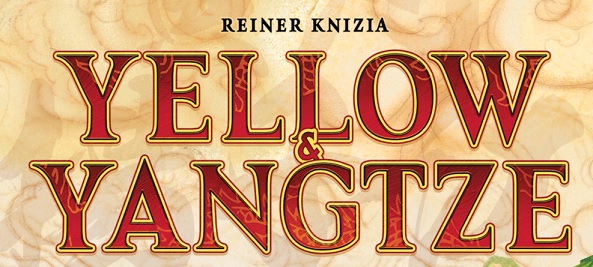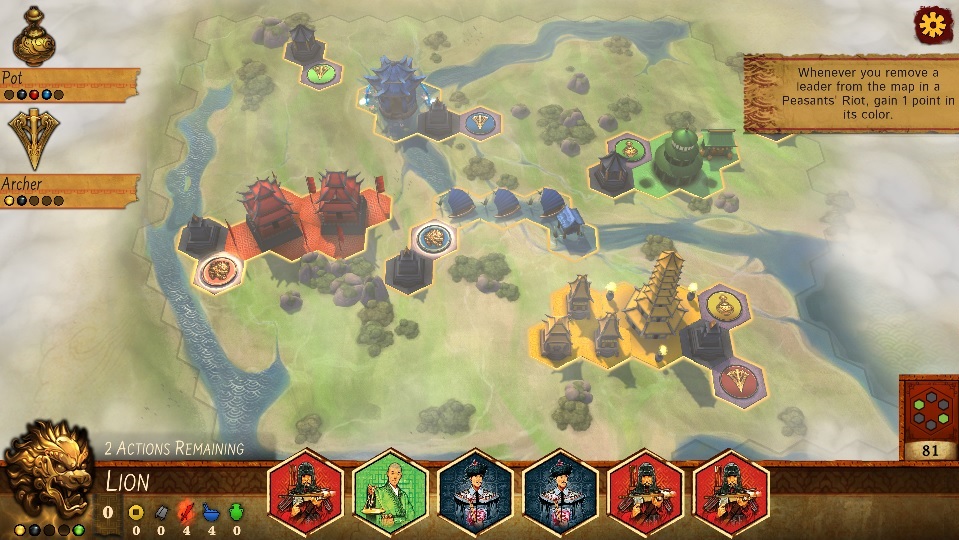Yellow & Yangtze is a tile-laying game with a lot of player conflict. It’s a spiritual successor to Tigris & Euphrates and shares many similarities with it. But how well does that translate to a screen?
Introduction
If you have a decent board gaming mileage, you’ve probably at least heard, if not played the 1997 classic from Reiner Knizia, Tigris & Euphrates. It was one of the first successful heavy strategy games, a tile-laying game with a lot of player-on-player conflicts.
Yellow & Yangtze is its spiritual successor and shares many similarities with it. First, it has two major rivers in its title. Second, the gameplay principles are pretty much the same, although Mr. Knizia has found a lot of room for improvement in 20 years.
So, first, we’ll take a look at how the game works. But since this review is for the digital version of Yellow & Yangtze developed and published by Dire Wolf, we’ll focus on how its game mechanics are suited and ported onto the digital edition.
Side note: I know what the world digital means and that I’m using it wrongly throughout this article (and other reviews of board games ported to screens). A proper adjective would be “electronic”, but as you know, a language is a living thing and I feel like the word digital is one of those that is changing its meaning.

How to play Yellow & Yangtze
The concept of the game is quite interesting. It’s unconventional and I needed half a dozen games to wrap my head around it. You’re placing leaders and tiles of different colors on the board, creating clusters of them, called states.
For each placed tile, you get a point, if you have a leader of that color in that state. For a cluster of 3 tiles (a pagoda), you get a point every turn. During the game, you can’t neglect any of the five colors, since only your lowest score count at the end.
This simple setting creates a deeply intense abstract game, full of player conflict. The players will inevitably try to get into different states, initiating revolts, states will link up, starting wars, and there’ll be a constant struggle to snatch a pagoda from other players or at least try to get a leader in – to be the one reaping the points income from that pagoda. Moreover, every tile color has its own special ability, as do your leaders.
So, you’re juggling multiple balls at once, while also keeping a close eye on what others are doing. Are they trying to exploit your vulnerability? How can you exploit theirs? Do you have enough black leader hexes to initiate a revolt? Or red soldiers to start a war?
The gameplay is extremely tense and cutthroat, often frustratingly so. There are no optimal moves, the tide is always shifting, reading other players is a thing, as is a bit of luck with the tile draw. But the experience is so different from any other board game, that you at least owe it to yourself to try it out.

Yellow & Yangtze Digital Edition Review
So, how does this work in the digital world? The first thing you notice is the technical part. The guys at Dire Wolf did a tremendous job. The graphics and the user interface are stunning. Every move is animated, from placing the tiles to pagodas rising and falling. There’s a lot of bling-bling and the game is a joy to look at. But this does slightly detract from the gameplay itself. A possibility to turn the effects off or just display the basic board would be welcome.
The first things you should get into are the tutorial missions, particularly if you haven’t played the tabletop version. The tutorial is one of the highlights of the content. It’s comprised of several parts that each teaches a certain gameplay concept; tiles, pagodas, scoring, wars, revolts, special actions, and powers.
It’s all you need to learn the game and it does more than a competent job at teaching. Yes, you do have to pay attention and read the instructions, but the experience is far more interactive and faster than having to read a wall of text in a rulebook.
Further content includes a 9-scenario long campaign. These play out just like your normal game, only the setting is pre-prepared (and rules slightly modified – extra points for certain actions and similar) and you have to adapt your strategy accordingly.
Then there’s solo skirmish play against 1-3 computer opponents. You can set 3 levels of difficulty (sadly, you can’t set it for each one of them individually) and they are more than competent opponents.
Multiplay includes pass-and-play for up to four players (behind the same screen), as well as online multiplayer. It’s not too populated, but you can play out of sync and have multiple games open.
Conclusion
The digital edition of Yellow & Yangtze is a great tool to learn the game, understand the flow and try various strategies. Especially since the game requires several plays to get a hang of it.
The long-term appeal is questionable though. Yes, there’s decent content, but a game of so much conflict loses a lot of the appeal when you can’t see the player sitting across from you.
Still, for the price the game is on offer, it’s a good buy.
More digital editions of board games:
